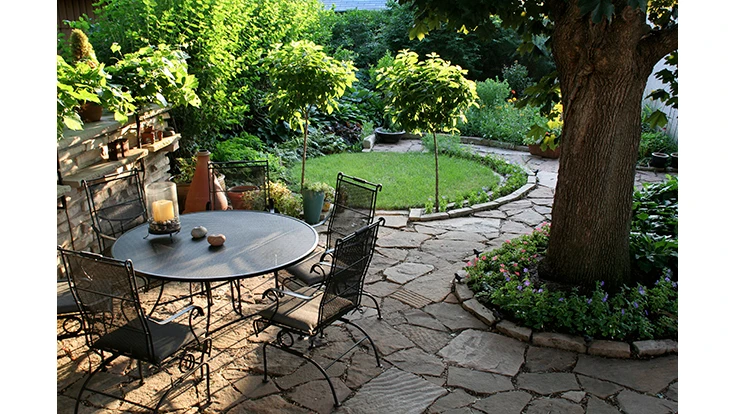
To get lawns through a hot dry summer, spring fertilizer applications are key. Not only do the nutrients help green up the lawn after the winter, it gives grass what it needs to gear up for the hot, dry summer months.
“You definitely don’t want to be skipping the fertilizer application in the spring or early summer,” says Arnie Arsenault, owner of A. Arsenault & Sons Landscaping in Spencer, Massachusetts. “As you’re coming out of the winter months, you’re trying to get the lawn to recuperate, to start to become healthy, so that in the heat of the summer, it will actually be able to sustain the types of summers that we have.”
Arsenault has been a landscaping business since 1979 and has been handling lawn care since 1987. Three years ago, the company became a Weed Man franchise and uses the brand’s mix of 65 percent slow-release fertilizer that feeds lawns for eight to 10 weeks.
As his business grew, Arsenault realized that one of the most important things to pay attention to is calibration. “Calibration is the most important thing we monitor,” he says.
To make sure the right rate of fertilization is being applied, technicians log how much they use at the end of each and every day. “If they’re using too much, they’re costing the company and if they’re using too little, the lawns will suffer,” Arsenault says.
While liquid applications may be necessary for a quick green-up for a special event or to repair some damage, Arsenault says, his company prefers granular to be better be able to handle different weather conditions like heat and rain. “You definitely don’t want a rainy spring to deplete your product, but you can’t control Mother Nature, and so that’s why we time the period of the bulk of our applications for the month of April,” he says.
Operators start applications in late March and continue throughout the month of April, but timing depends on the weather in your area. Two years ago, Arsenault wasn’t able to start fertilizer applications until the second week of April due to 3 feet of snow on the ground, but this year they were able to start in March.
On the other end of the spectrum, if the weather is too hot, Arsenault works with its customers to make sure grass is getting the inch or inch and a half of water it needs every week. Otherwise, the grass will go dormant. “But getting that fertilizer is really important to be able to ride out those periods,” Arsenault says, noting that his schedule allows his operators to avoid really hot times of the year when making their four annual fertilizer applications.
And the team doesn’t deviate from that schedule. This year, clients started calling in the second week of March, so they got a reminder that applications are timed for the whole year. “Really lawns don’t start going until mid-March which falls into our timeline,” Arsenault says.
Sponsored Content
Lawn and Landscape Marketing on a Budget
Digital marketing can feel overwhelming when you’re working with a limited budget. Websites, SEO, social media, and paid ads can quickly add up, but you don’t need to do everything to see results. By focusing on cost-effective strategies, you can still make a big impact without overspending.
Sponsored Content
Lawn and Landscape Marketing on a Budget
Digital marketing can feel overwhelming when you’re working with a limited budget. Websites, SEO, social media, and paid ads can quickly add up, but you don’t need to do everything to see results. By focusing on cost-effective strategies, you can still make a big impact without overspending.
Sponsored Content
Lawn and Landscape Marketing on a Budget
Digital marketing can feel overwhelming when you’re working with a limited budget. Websites, SEO, social media, and paid ads can quickly add up, but you don’t need to do everything to see results. By focusing on cost-effective strategies, you can still make a big impact without overspending.
Sponsored Content
Lawn and Landscape Marketing on a Budget
Digital marketing can feel overwhelming when you’re working with a limited budget. Websites, SEO, social media, and paid ads can quickly add up, but you don’t need to do everything to see results. By focusing on cost-effective strategies, you can still make a big impact without overspending.
Sponsored Content
Lawn and Landscape Marketing on a Budget
Digital marketing can feel overwhelming when you’re working with a limited budget. Websites, SEO, social media, and paid ads can quickly add up, but you don’t need to do everything to see results. By focusing on cost-effective strategies, you can still make a big impact without overspending.
Sponsored Content
Lawn and Landscape Marketing on a Budget
Digital marketing can feel overwhelming when you’re working with a limited budget. Websites, SEO, social media, and paid ads can quickly add up, but you don’t need to do everything to see results. By focusing on cost-effective strategies, you can still make a big impact without overspending.
Sponsored Content
Lawn and Landscape Marketing on a Budget
Digital marketing can feel overwhelming when you’re working with a limited budget. Websites, SEO, social media, and paid ads can quickly add up, but you don’t need to do everything to see results. By focusing on cost-effective strategies, you can still make a big impact without overspending.
Get curated news on YOUR industry.
Enter your email to receive our newsletters.Latest from Lawn & Landscape
- Sgro named Yanmar Compact Equipment's North American president
- Aphix acquires Curb Appeal Landscaping in Birmingham
- Project EverGreen helps revitalize Milan Park in Detroit
- Trex Company wins Product of the Year, Judges’ Choice Winner at Environment+Energy Leader Awards
- General Equipment & Supplies in Fargo adds Takeuchi equipment
- Mariani Premier Group acquires Hazeltine Nurseries
- EnP Investments adds Mark McCarel as Northeast territory sales manager
- Our April issue is now live






